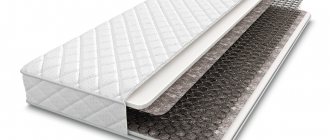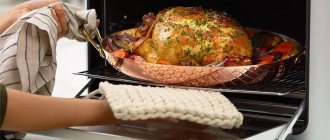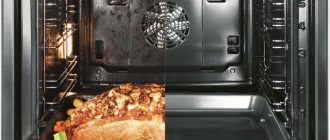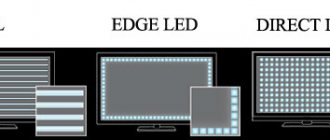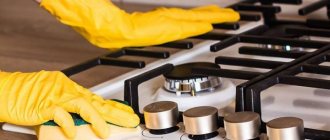Relatively recently, as an alternative to gas and electric ovens, a completely unique model appeared on the market - an induction cooker. These devices did not gain much popularity in the city, but residents of suburban villages appreciated them. And the point here is not that this technique belongs to the category of “economical”, because in fact it consumes little electricity. The point is the compactness of the device and excellent performance characteristics.
Induction two-burner hob Source images.kz.prom.st
What are the advantages?
The induction cooker has a number of advantages that distinguish it from its competitors.
Of the main ones:
- Maximum efficiency due to the start of heating the dishes immediately after switching on, and this saves electricity;
- Reliable protection against “wrong” dishes. The burner will not turn on if there is a frying pan or pan with a non-magnetic bottom on the stove;
- Automatic shutdown when removing dishes;
- Maintaining the set temperature at a certain level. This is due to the fact that the monitoring sensor is not affected by the high temperature of metal products;
- Stable power that does not depend on the voltage of the household network;
- A wide selection of programs, which allows you to prepare dishes of varying complexity;
- The induction surface is heated only by the cookware, so the likelihood of getting burns is extremely low;
- No unpleasant odors;
- Ease of maintenance. Most modern models have a glass surface, the processing of which is not difficult. The outside of the dishes does not burn due to the absence of open fire and hot surfaces.
Among the disadvantages, it is worth highlighting the high power, which creates an additional load on the wiring, the presence of electromagnetic radiation and the possibility of using only special utensils.
In addition, if you turn on all the burners at the same time, they will not produce full power.
Table: rating of popular models for home use for 2022
| Brand/Model | Number of burners | Number of additional functions | General characteristics based on reviews | Average cost in rubles | Rating |
| Electrolux EHH 6340 fok | 4 | 4 | An affordable, cost-effective model with basic features. Practical, easy to use, equipped with sound indicators. Housewives note the speed of cooking and safety. Despite the fact that it does not occupy the highest position in the rating, it is considered one of the most successful panels for independent installation. | 24 thousand | 4,5 |
| Zanussi ZEI 5680FB | 4, including one dual-circuit | 4 | According to buyers, this model is the optimal combination of price and quality parameters. The absence of a large number of additional functions greatly simplifies the control of the stove and is regarded as an advantage rather than a disadvantage. It is due to this that the panel has a relatively low cost. Consumer reviews are mostly positive. | 20 thousand | 4,8 |
| BOSCH PUE631BB1E | 4 | 4 | Reviews about this model are mixed. In some cases, noisy mode switching indicators become an obstacle to a high rating. Also, some consumers note that it is impossible to cook on three burners at the same time due to the appearance of extraneous noise when the induction coil pulses on and off. At the same time, this panel is praised for its high level of energy saving. | 28 thousand | 4 |
| Siemens EX375FXB1E | 2 | 4 | The model earned a solid “B”, thanks to its comfortable ergonomic design and durable operation. Despite a number of negative reviews, we can say that all the comments are a subjective assessment of buyers that do not reflect the true technical capabilities of the presented model. | 39 thousand | 4 |
| BEKO HII 63500 HT | 3 | 4 | Practical mid-range induction cooker from a Turkish manufacturer. A few customer reviews confirm the convenience of the panel and ease of use. | 29 thousand | 4 |
Gallery: review of popular induction panels
Electrolux EHH 6340 fok is one of the most practical models of induction cookers, according to customers
The Zanussi ZEI 5680FB induction hob fits well into any style interior
Classic and inexpensive option - BOSCH PUE631BB1E
The ergonomic and stylish design of the Siemens EX375FXB1E panel is perfect for small kitchens
HII 63500 HT - a convenient three-burner option from BEKO
What types of induction cookers are there?
The following types of induction cookers are available for sale:
- Portable (desktop). They are small in size and have one burner;
- Built-in - combined with furniture in the kitchen;
- Combined. There are stoves on which one half of the burners operates according to the standard electric principle, and the second - according to the induction principle.
Scheme.
What to look for when choosing
Of course, the type of hob is not the only parameter that needs to be taken into account before purchasing. Whatever you ultimately choose - electricity or induction, you should pay attention to other details.
Characteristics
. We are talking primarily about power, connection features and dimensions. As a rule, such appliances are built-in, so its dimensions are extremely important to take into account when choosing so that the panel fits perfectly into the kitchen unit. But other characteristics deserve attention:
- number of burners. For large families, the standard 4 are suitable; for those who rarely cook or live alone, 2 or 3;
- control. Usually it is touch-sensitive - a separate zone is allocated on the panel in which the parameters of the burners are configured;
- availability of additional functions. Pay attention to them, especially those related to safety: overheating protection, power lock or recognition of the presence of dishes. A convenient addition is a timer or light indicator for the operation of the burner.
Manufacturer
. When choosing complex equipment, you should not save money and turn to unverified manufacturers. It is better to purchase products from a reputable company and get a panel of which you are confident. GranFest™ has been on the market for more than 15 years, has 12 prestigious awards and improves technology year after year. We suggest taking a closer look at the models of built-in appliances in the catalogue. You will find both induction and electric panels with different characteristics: the choice is up to you.
What are the differences from other plates?
Induction cookers compare favorably with other types of stoves (gas and electric).
A number of points are worth highlighting:
- The efficiency of induction furnaces reaches 90%. For comparison, in gas stoves this figure is only 30-60%, and in electric stoves - no more than 70%;
- High heating rate (devices with heating elements or gas burners cannot boast of this feature);
- Efficiency. After removing the dishes, you do not need to turn off the work area manually - this happens automatically. In electric or gas stoves, the burner continues to work, which leads to excessive consumption of gas and electricity. In the summer, this is especially important, because there is additional heating of the air, which complicates the process of air conditioning (cooling) the room;
- Precise temperature control. On stoves with heating elements or those running on gas, temperature control occurs “by eye”. In the case of induction cookers, you can maintain the same setting throughout the entire cooking time;
- Safety. If a person accidentally mixes up the cookware and places a product with a non-magnetic bottom, the burner will not work. To activate the burner, the cookware must cover its area as much as possible, 50% or more;
- Many additional functions that classic gas or electric stoves cannot boast of.
Reviews from consumers of household appliances with induction heating
The easiest way to learn about the advantages of an induction hob over electric and gas hobs is from reviews.
- Elena, 36 years old: “Water boils faster than in an electric kettle! When the milk runs out, there is no smoke and no problems with cleaning the surface. And when frying fish or meat, when the meat splatters a lot, I simply cover the panel with newspaper, and then there is no need to wash it. Each burner has its own timer. However, the adapter disk rings when the stove is turned on. And because I didn’t use it correctly the first time, it ruined the surface. And now there is an ugly mark on it.”
- Igor, 23 years old: “The stove can do everything that they write about the advantages of such surfaces: heating, cooling, and a timer. But if water gets on the panel during operation, it turns off, and you can continue working only by wiping it off. It's not always convenient."
- Alexander, 40 years old: “The stove is very powerful, multifunctional with independent control of the burners. And the presence of sides prevents spilled liquid from spreading throughout the kitchen. However, the stove is a little noisy when turned on at maximum power. Maybe it just depends on the model.”
- Katerina, 19 years old: “I was surprised by the speed of heating. At first I couldn’t get used to how quickly the water boiled, so it often boiled over. And once I had a chicken that was boiling burnt, and there was a mark left on the burner that can be seen from a certain angle.”
- Olga, 45 years old: “Induction is a miracle. The cookware heats up almost instantly. But you have to get used to it the first time. I like that it is easy to clean. But in some places where the dishes were once burnt, traces remain that must be removed separately with a scraper.”
- Elena, 19 years old: “I’ve never had anything burn on this stove: neither scrambled eggs nor porridge. But the heating rate is simply amazing.”
Induction hobs speed up cooking and reduce cleanup time. This is due to the special glass-ceramic coating. After analyzing all the reviews, taking into account the pros and cons and reading about the nuances of the stoves, there are no longer any questions left about how to choose an induction panel. And despite widespread myths about its health hazards, induction is becoming increasingly interesting. However, many are still afraid to buy it. But you can be sure that everything will be fine if you follow the recommendations for using the surface.
Working principle of an induction cooker
Before using an induction stove, it is advisable to understand the principle of its operation. It is built on electromagnetic induction - the mechanism of electric current flow when the magnetic flux changes.
The principle of operation of an induction cooker is similar to that of a transformer. Under the glass-ceramic surface of the device there is an induction coil, under which a current flows with a frequency of 20 to 100 kHz.
The role of the primary winding is played by the induction coil, and the secondary winding is played by the cookware installed on the burner.
As soon as the product is placed on the work surface, induction currents appear, heating pans, pots and other cooking products.
As for the glass-ceramic surface of the stove, it also warms up, but from the dishes, and not from the work area.
In relation to the principle of operation, it is worth highlighting a number of points:
Power regulation
As noted above, the cookware is heated by high-frequency eddy currents acting on it. In this case, the power of the burner can be adjusted in two ways - pulsed or continuous.
In the first case, the stove will periodically turn on and off. Depending on the installed power, the operating frequency also changes.
At the maximum power setting, the frequency reaches 50-100 kHz, and if it is reduced, it reaches 20 kHz.
Heating area
The operating principle of an induction cooker is designed in such a way that the surface near the heating zone remains cold, and this reduces the risk of burns.
As for the heating elements used, they come in several types:
- Tape. They look like a tape twisted like a spring. Heating time is 8 seconds;
- Spiral. By the name you can judge the design of the part. The surface heats up within 15 seconds;
- Halogen. This heater looks like a tube filled with halogen gas. There is a special heater inside (it is through it that the current passes). Thanks to this operating principle, the cookware heats up almost instantly after switching on. The maximum temperature is reached 3 seconds after switching on;
- Induction. Such devices create a high-frequency field that heats the bottom of the cookware.
Features of cooking on an induction oven, which cookware is suitable
As noted earlier, for such a stove it is worth acquiring special dishes with a magnetic bottom.
The oven automatically recognizes a suitable design and is immediately activated after turning the burner handle.
It is allowed to use utensils:
- Made of cast iron;
- Made of stainless steel;
- Enameled, with a flat bottom.
If the bottom of the cookware is made of steel, but there is a layer of enamel on it, the use of such a product is allowed. This is due to the fact that the magnetic field does not “pierce” the enamel layer.
How does an induction cooktop work?
What is special about induction cookers and why do many still view them with some mistrust? The fact is that the very principle of heating here is completely different from what we are used to observing. Typically, heating is carried out using a heat source. This can be either a flame (bonfire or gas burner) or an electric heater. From the heat source, the dishes are heated through heat transfer, and then their contents.
There is no heat source in an induction cooker. Under the glass-ceramic panel are hidden inductor coils, which do not heat up (or almost do not heat up) when an electric current passes.
What's the secret? When electric current passes through such a coil, an electromagnetic field arises, creating eddy currents in nearby objects made of ferromagnetic material (in our case, iron utensils). It is these currents that heat the dishes, and then the food inside is heated.
1. Glass ceramics. 2. Copper coil.
3. Magnetic field. 4. Ferromagnetic bottom of the cookware.
As you can see, the idea is simple and witty. True, it is simple only for those who are familiar with physics. Everyone else will just have to believe: it works!
Harm to health
Today there is a lot of discussion regarding the harm of induction cookers, because the principle of their operation is based on electromagnetic fields, the negative effects of which are well known. Many experiments have been carried out on this matter.
Scientists have proven that at a distance of one centimeter from the source, electromagnetic radiation is always higher than the permissible ICNIRP standard.
If the pan is displaced relative to the center of the working surface or in a situation where its diameter is smaller than the diameter of the burner, the indicated indicator will be greater than the norm at a distance of up to 12 cm.
This parameter is typical for cases when special utensils are used for cooking. If there is an enameled object on the work surface, the danger zone is larger - up to 20 cm.
Why is this dangerous for health?
The electromagnetic field that occurs near the human body can lead to the appearance of induced currents in the body and a negative effect on the central nervous system. To protect health, ICNIRP has established requirements for upper current limits.
To verify whether induction cookers meet these standards, a study was conducted with a group of volunteers of different ages and genders.
People were located in close proximity to the hob (at a distance of five centimeters). Scientists at this moment studied the currents that flowed in the body and the central nervous system of the body.
It has been proven that the current indicators in the case of using built-in models are minimal.
As for portable models, their current indicators are higher, but they also did not exceed the established norm.
It is worth noting that the limit established by ICNIRP is 50 times less than the minimum threshold at which stimulation of the human central nervous system occurs.
What is the outcome of the study?
Experts published the results of the experiments, but admitted that there is not yet enough information about the dangers of electromagnetic fields. It is important to understand that the nature of such radiation may vary depending on the nature of its occurrence.
There is another study, the results of which can be found on the WHO website.
People and animals took part in the experiment, but it was not possible to prove the negative effect of electromagnetic radiation on the central nervous system or the cardiovascular system.
Cons of induction cooktops
Many users recognize the benefits of induction as a more efficient heating method. However, induction panels, which have a huge number of undeniable advantages, are not yet very popular among Russian buyers. What is the reason?
Firstly, induction is an unusual thing for the average person, and therefore causes some caution. Secondly, the induction hob also has its disadvantages.
Higher cost
The main disadvantage of induction hobs from the point of view of the average buyer is their high cost. Technically more advanced, more “advanced” induction panels are indeed more expensive than stoves with Hi Light burners, and even more expensive than conventional electric stoves. Having just appeared on the market, they scared off many potential buyers precisely because of their price. But time passes, and induction is gradually becoming a more accessible pleasure.
In order not to be unfounded, we will present a few numbers. The cost of an average induction hob from a well-known manufacturer today is about 20 thousand rubles. There are models that will cost you even less – 10-15 thousand. (Of course, we are not talking about slabs in the premium price segment, the price of which is comparable to the cost of a budget car.) For comparison: a glass-ceramic panel can be purchased for 15-18 thousand. As you can see, there is no reason to break spears.
The difference in price between induction panels and electric stoves with cast iron burners is, of course, somewhat larger. However, it is worth taking into account that if you “overpay” at the stage of purchasing a stove, you will very soon compensate for this difference due to more economical energy consumption.
Cookware with ferromagnetic properties is required
The housewife who has become the owner of an induction hob will have to reconsider her “fleet” of kitchen utensils. Not every pot or pan will work. The fact is that when using this panel, heating occurs directly in the bottom of the cookware due to the occurrence of induction currents in it. It is clear that this dish must be special.
A cook does not necessarily need to know the intricacies of physics. Simply, you should remember that you can only use dishes whose bottom is made of a material with ferromagnetic properties. Such products are today produced by almost all manufacturers of kitchenware and are designated with a special sign.
Designation of cookware for induction hobs.
But what about old dishes? Do you really have to give up your favorite saucepan or saucepan? Not at all. Steel and cast iron utensils will still serve you well. But, alas, you will have to give up aluminum, copper, brass, glass, ceramic cookware, as well as cookware made from thin-walled steel or layered materials. In addition, the bottom of the vessel must be perfectly flat: differences of more than 1 mm are unacceptable.
It’s quite easy to check whether your old cookware, which does not have special markings, is suitable for the induction panel: just attach a regular magnet to the bottom. If it holds, it means everything is in order, the dishes will “remain in service.”
In fact, you don't even have to do this simple procedure with a magnet. Most models of induction cookers have a cookware recognition function and will tell you whether a particular cookware is suitable for them or not. If the pot or pan does not have a ferromagnetic bottom, the panel simply will not start working. As you understand, it is impossible to damage an induction hob by putting something wrong on it: in this case, the device simply will not turn on.
Installation restrictions
The installation of an induction hob has some peculiarities, and we advise those who like to install household appliances solely in accordance with their own ideas about physics and life to look at the instructions.
It is not allowed to install the panel above other household appliances (the only exception is an oven manufactured by the same manufacturer and having a built-in cooling fan). It is very important to comply with all clearances specified in the operating instructions.
It is strongly recommended not to store aerosols and other flammable materials, as well as foil and metal objects near the induction hob, including in the drawer located underneath it.
Do not place metal objects on the surface
The induction hob reacts to objects made of ferromagnetic materials, so you should not place metal objects on its surface. Many modern models are able to estimate the area of contact with the cookware, and if during the cooking process you place a small object, such as a knife or spoon, on the hob, nothing will happen - the stove simply will not react to the appearance of such “small things”. But you will have to get out of the habit of storing empty pots or pans on the hob that have no place in the cabinet.
Limited uptime
The induction hob is designed for continuous operation for only 3 hours. After this time, it will automatically turn off and, if you need it, you will have to turn it on again. This limitation will create some inconvenience for lovers of jellied meat, which, as you know, needs to be cooked for 6-8 hours.
The impact of induction hobs on the human body
Another barrier to purchasing an induction hob for many potential buyers is the fear of electromagnetic radiation. At the same time, this category of especially wary citizens for some reason forgets about microwave ovens, televisions, computers and other electrical appliances, the level of electromagnetic radiation of which is no less, and sometimes more, than that of induction cookers.
When talking about the dangers of induction hobs, they do not try to give up mobile phones, which can cause much greater harm to health, since many people do not part with their gadgets even for a second.
Modern science’s understanding of the effects of electromagnetic radiation on the human body can be considered more than limited. The age of electronics, in fact, has just begun, and scientists are not yet able to predict all the adverse consequences of this impact on human health in the long term.
That is why WHO adheres to a precautionary policy in this matter. It is not recommended to get too close to the induction hob. This will significantly reduce the risk, because exposure to electromagnetic fields decreases as distance increases. True, users inevitably have a question: how to cook a dish remotely?
Manufacturers themselves speak about the need to maintain a distance of 10-30 cm. This applies, however, not to all users, but to people with pacemakers. In general, the instructions for use recommend that people with such implantable medical devices seek the advice of a physician. But do doctors know how induction panels work and how their work affects medical devices?
Recommendations for use
Users who prefer an induction cooker should take into account the following points:
- Do not use dishes with obvious signs of damage or those with a convex bottom;
- It is advisable that the pots and pans used cover the work surface of the burner. In this case, the dishes should be located exactly in the center of the heating area;
- While the induction cooker is operating, stay away from it and do not touch the surface;
- When purchasing cookware, pay attention to the special notes in which the manufacturer notes the possibility of using the products on an induction hob;
- When stirring food, use non-metallic utensils.
How to use an induction hob. Simple instructions
Nuances of the right choice
In order for you to be as satisfied as possible with your purchase and not regret it later, you need to understand the nuances of choosing slabs. We already wrote above that there are many varieties of them. Not all of them are suitable for home use. Moreover, if you want to feel the efficiency of such panels, you need to understand all their details.
When choosing an induction hob, be sure to check which burners are on it. The fact is that induction panels are a type of electric, but with their own special operating principle. Externally, all types of electrical panels - induction, rapid, spiral, strip, halogen - are similar, but each has its own technology. It's easy to confuse them.
On some models you can only cook one dish. They do not have the ability to cook several at once. Don't forget to clarify this nuance. If you are buying a stove for your home, do not choose one that is too expensive. They tend to have very different features that you won't need. Such panels are designed for use in restaurants and cafes. Induction hobs offer the widest variety on the market. In addition to different colors, you can also choose a shape: square, round, arched, hexagonal or triangular. And some studios create panels according to individual drawings. If you do not plan to change the dishes to ones specifically designed for this type of panel, then buy a special adapter disk.
There are already many different brands on the market that offer induction. But choose panels only from manufacturers you trust. Don't be fooled by the low price of an unknown company. It’s better to pay more money than to throw away the purchase a month later. A small family should take a closer look at small models with two heating zones. But if you have a lot to cook, then it is better to choose those that have many burners. Remember that some models have a function to increase the heating zone. Thanks to it, you can place large dishes on the stove.
Be sure to measure the parameters of the place where you plan to place the purchase. This is necessary so that there are no gaps between the panel and other surfaces. They are quite large, so they need quite a lot of space. If it is just a hob, then it cannot be placed above the oven.
See if the selected model has a residual heat indicator. It is convenient because you will know exactly how long to wait until the cookware is completely heated.
Check the quality of the panel. Tap it. It should be dense and durable. Study it carefully. If there are scratches on it even before purchasing, it is better to leave it in the store. Below we will introduce you to the pros and cons of an induction cooker.
Induction cooker malfunctions
The electromagnetic principle of operation of an induction cooker implies high reliability and durability of the device.
Despite this, some breakdowns are possible during operation:
- Low burner power. The likely cause is improper installation of the utensils, which are not located in the center of the work surface. It is possible that the diameter of the pan (pan) is smaller than the diameter of the heated zone. Other reasons include incomplete adherence of the cookware to the surface or overheating of the induction winding;
- The burners on the left side of the stove do not work. The probable cause is a breakdown of the control unit or power board;
- Failure of one of the work areas. Before cooking, it is important to follow a certain sequence of inclusion. First, the burner is selected (using the touch panel), and then the power is set. If everything is done correctly, check the cookware used to ensure it matches the induction cooker (in diameter and material). If the cookware complies with the rules, but the comfort still does not work, activate the temperature sensor test and replace it (if necessary). If the sensor is working properly, make sure that the dishes fit tightly to the surface;
- Two burners on the right side do not work. The cause of the malfunction often lies in poor contact of the terminal box or a blown fuse. It is worth checking the quality of the connection between the control unit and the power board. As a last resort, the unit needs to be replaced;
- The residual heat indicator has failed. Actions - carrying out a test check, the results of which conclude that the temperature sensor is working properly. If the part is in good condition, the control unit is replaced. If the display malfunctions, it is worth checking the quality of the connection between the panel and the control unit;
- The cooking zone does not turn on and there are no messages on the screen. Check the power switch, fuse, and the quality of the connection between the control unit and the power board and touch panel;
- Cooling fan failure. Pay attention to the installed power. If it is minimal, the fan will not work immediately, but after the air temperature reaches 50 degrees Celsius. Do a test run. If the fan fails, replace it. If this unit is in good condition, replace the control unit;
- The induction hob beeps continuously. The probable cause is failure of the control unit;
- The maximum power burner (3 kW) does not work. Switching on the work zone is sometimes blocked to prevent overheating of the induction hob unit. If the problem appears for no reason, the control unit is replaced;
- Automatic switch-off of the hob. The operating principle of an induction cooker is designed in such a way that it switches off in three cases. Firstly, if the time was set by a timer. Secondly, if the burner operates for more than two hours. Thirdly, when after 10 seconds after switching on, no action occurs.
Pros of induction cooktops
Induction cooktops have perhaps more advantages than household cooktops with other types of heating. They are more energy efficient, easier to use and more functional.
Low power consumption
Compared to other types of heating elements, an induction panel uses the energy it consumes very efficiently. The heat is not generated inside the burner, but directly in the bottom of the cookware, resulting in minimal thermal energy loss. If we compare induction burners with Hi-Light, the former are 20-30% more economical, and this is quite a significant difference.
Of all the hobs used today, induction ones are characterized by the highest efficiency - 90-93% (for electric hobs with cast iron burners this value is 53-56%, and for gas burners even 49-52%).
Induction hob - efficiency - 90-93%
Hob with cast iron burners - efficiency - 53-56%
Hob with gas burners - efficiency - 49-52%
Fast heating
An equally significant advantage of induction panels for many buyers is the high speed of heating pots and their contents. Practice shows that they surpass even good gas burners in terms of heating speed, let alone electric stoves with ordinary cast iron “pancakes”. It's not even speed, it's super speed.
This feature of induction panels is explained quite simply. When a traditional burner is operating, the heating element first heats up, from which the surface of the burner itself heats up, the latter already gives off its heat to the pot or frying pan standing on it.
With the induction heating method, there is no such multi-stage process: the cookware is heated not due to heat transfer, but due to the appearance of eddy currents in its bottom when an electromagnetic field is applied. It is this direct, “targeted” effect that ensures rapid heating. In addition, the induction hob is characterized by a lightning-fast reaction to any change in mode, which housewives really like, since this creates ideal conditions for preparing various dishes.
Low heating of the hob
Since an induction hob does not have heating elements, its surface temperature during operation does not rise as much as other types of household stoves. The glass-ceramic surface heats up, but only from the bottom of the pot or pan standing on it.
To evaluate, let's give a few numbers: cast iron burners heat up to 250-280°C or more during operation, Hi-Light - to almost 500°C, and the surface temperature of a working induction panel does not exceed 80°C. (At such low values, the residual heat indication seems a bit of a redundant function, however, almost all modern hobs provide it.)
As you can imagine, this makes working with an induction cooker much safer. You will not get burned if you accidentally touch the work surface while cooking. This quality will certainly be appreciated by families with small children.
Low surface heating.
Easy to care for
Due to the low temperature of the hob, food accidentally placed on it will not burn. In addition, to wipe the burner, you won’t have to wait long for it to cool down. This greatly simplifies the process of polishing up after finishing the work, which means that the “escaped” milk will not upset you so much.
You can wipe off escaped milk without turning off the panel.
Ease of preparation
All housewives who have tried induction cookers are unanimous in their opinion that cooking on them is very convenient. And we are talking not only and not so much about high heating speed and accuracy. Due to the absence of thermal inertia, induction cookers react very sensitively to any changes in settings, including a decrease in power: when adjustments are made to the mode, the temperature changes almost instantly. The presence of many very useful functions turns cooking into a fun and easy process.
Technical advancement
The undoubted advantage of induction hobs is their technical advancement. They can do much more than their “ancestors” with cast iron burners, and have a number of functions that are not available for other types of hobs.
Would you like some examples to support these words? Please…
An induction hob can detect the size and shape of the bottom of a pot or pan placed on it. Current will be supplied only to those coils that are located directly under the bottom of the dish. In other words, the size of the heating zone automatically adjusts to the area of the cookware. This increases the heating efficiency and efficiency of the device.
In some models, it is no longer necessary to precisely align the dishes along the contour of the burner - it will be quite enough to simply block the cross in its center. That is why some of the heating zones are designated quite arbitrarily, for example, by a large rectangular field.
The PowerMove or PowerSlide function allows you to change the heat intensity by simply moving the cookware across the hob surface.
This is not all that induction cooktops can do. But you will still have the opportunity to become more fully acquainted with the functionality of the average induction cooker.
Manufacturers are constantly improving the control system for induction hobs to make it as easy as possible for the user to enter settings and make this process more intuitive. Some models, for example, have separate buttons for each power level, which allows settings to be made in one or two touches. Other models have touch sliders that allow you to select an operating mode by simply sliding your finger along the scale.
Relatively recently, circular sliders have appeared that imitate the operation of the rotary controls familiar to everyone. There are, however, more unusual solutions, such as, for example, a control unit with a magnetic removable Twist Pad element.
Most induction hobs have the ability to lock the control buttons - a useful option if there are small children in the house. But so far only a few premium-class induction cookers are equipped with touch displays that reflect the operating mode of the device, the settings of individual zones, the location and shape of the cookware, etc.
Connectable heating zones
For many models of induction hobs, heating zones (burners) can be combined if necessary. This means that they will temporarily work together as one, and accordingly have common settings. This allows you to cook not only in standard-sized pots and pans, but also in large-sized dishes (grill pans, roasting pans, etc.), as well as in irregularly shaped dishes (for example, a duck pot). A similar function is called Bridge.
Determining the presence of dishes
Almost all modern models of induction panels have a function for recognizing the presence of cookware: the burner will not work if there is no cookware on it. Housewives now do not have to worry that they will forget to turn off the stove after finishing cooking dinner - it will turn off itself as soon as the pan is removed from its surface.
By the way, the panel will not work even if the area of contact of the dishes with the hob is too small. This means that you can safely leave a spoon or knife on it - the stove will not turn on and start heating them.
Stop&Go function
The Stop&Go function, which has also become quite common, allows you to pause the cooking process for a while by turning off a working burner or turning it to the minimum power level. The housewife can now easily leave the kitchen if necessary, without fear that a dish that requires attention will be spoiled. By pressing the Stop&Go button again, it will resume the process with the settings in effect before the stop being restored.
Pause
The “Cleaning-pause” function allows you to stop the operation of the induction coils for 20-30 seconds so that the user can wipe the control panel or collect spilled cereal or spilled liquid from the hob. This function has not yet received mass distribution and is found only in a few models.
But blocking the panel from unauthorized changes to settings, in other words “child protection,” is in great demand, and therefore is found on almost all induction cookers.
Intense heating
If you need to heat the contents of the pan even faster than an induction hob usually does, you can use the intensive heating function (different manufacturers call it differently - Power, Booster, Powerboost). In this case, the power supply to this burner will be increased at the expense of the adjacent burner (of course, the power of the “assistant” will be temporarily greatly reduced).
In some models, electricity can be removed not even from one, but from two adjacent burners (Twin Booster). The amount of power on the “powered” burner, as a rule, increases to 2.5-3.5 kW, and for some models to a previously unimaginable 4.5 kW. For security reasons, this function is time limited (usually no more than 10 minutes).
Cooking control functions
Control functions, which, unfortunately, are not available on all induction cookers, significantly simplify the cooking process. For example, the “Boiling Control” function will allow the housewife not to wait near the stove for the contents of the pan that has just been placed on the stove to warm up. After activating this function and selecting the main cooking mode, you can calmly go about other things: the hob itself will start working at maximum power, and when the water boils, it will switch to the set mode.
Many housewives will appreciate the “Keep Warm” function. The induction hob will maintain the temperature at 40-70°C. As a result, the finished dish will not burn or dry out, but will remain warm until the household finally gathers at the dinner table.
Some induction cookers have automatic programs for maintaining optimal temperature conditions for preparing various foods and dishes (eggs, fish, vegetables, soup, etc.).
The timer, which until recently was a rarity, is now found in 80% of manufactured induction panels. At the same time, you can increasingly see a more advanced version of it - a timer with automatic shutdown of the device. There are even economical timers that turn off the heat a little earlier than the appointed time in order to complete cooking using the residual heat.
What the market offers, main manufacturers
Below is a brief overview of the most popular manufacturers and some of their products today.
Skvara
This developer markets professional induction cookers that can be used in cafes and restaurants.
Their advantages include greater efficiency, the fastest heating of dishes, the presence of a timer and temperature controller, as well as ease of maintenance.
Here are some manufacturer models:
- 2-burner induction cooker Skvara Sif 2.4 4 kW.
- Stove FROSTY BT-E35.
- Professional oven Skvara Sif 4.8.
Electrolux
The most popular models of induction furnaces from Electrolux include:
- Electrolux EKI 54550 — stove with heat indicator, glass-ceramic surface. Number of burners - 4. There is an electric oven with a volume of 60 liters and a power of 3.7 kW. Among the additional functions, it is worth highlighting convection and grill. The width of the slab is 0.5 m.
- Electrolux EKI 6451 - an equally popular model, which is similar in characteristics to the stove described above. The difference lies in the width (0.6 m), volume and power of the electric oven (72 l and 3.6 kW, respectively).
Gorenje
The following models are worth highlighting from this manufacturer:
- Gorenje EI 637E21 — induction hob with heat indicator and glass-ceramic top. There are four work areas for cooking. There is an electric oven with a capacity of 66 liters. Among the additional functions, it is worth highlighting the grill and convection.
- Gorenje ICG 3400 — induction hob with two heating zones. The surface is made of plastic. Product width 0.6 m.
Hansa
This manufacturer offers a wide selection of cookers, including induction-type products. One option is the Hansa FCIW58277 stove with heat indicator.
The surface is made of glass ceramics. The number of hobs is 4. There is an electric oven with a capacity of 65 liters. The width of the product is 0.5 m. Additional functions include convection.
Saturn
The brand's products have an affordable price and relatively high quality. Among the manufacturer's induction cookers, it is worth highlighting the Saturn ST-EC0187.
There is only one induction burner here. The surface is made of glass ceramics. No additional functions are provided.
Advice from professionals on proper operation and care of the device at home
A simple and important tip for caring for the glass-ceramic surface of an induction hob is to clean it in a timely manner. Don't wait for spilled food and crumbs to stick to it - wipe the stove immediately after cooking with a damp cotton or microfiber cloth. Experienced housewives confirm that this is the best way to preserve the neat appearance of a household appliance for a long time, and manufacturers agree with them.
Specific care rules are prescribed in the instructions for the hob:
- Do not use high pressure cleaners or steam appliances as this increases the risk of electric shock!
- Before cleaning or repairing equipment, unplug it.
- Do not use the glass-ceramic surface of the induction hob as additional storage space for bowls, cutlery and other kitchen items. This increases the fire hazard of operation and contributes to the appearance of abrasions and scratches on the coating, which spoil the appearance of the slab.
- It is recommended to contact the service department once every two years to test the induction hob for performance. This helps to identify faults in a timely manner and extend the life of the equipment.
- Please note that some manufacturers prohibit the use of adapters for induction cookers, as this may cause a fire. In the instructions, such adapters are called induction rings or induction bases.
- It is not recommended to use dishes whose bottom is wider than the marked outline.
- It is important to keep the touch panels of hobs clean and dry at all times. To do this, just wipe them with a paper towel after cooking.
- Never place food wrapped in foil on an induction hob.
- To avoid scratching the glass-ceramic coating, use cookware with a smooth, clean bottom.
- Remove dried food particles using a special scraper. It is included in most of all models on the market.
- Wash only when the surface has cooled. Apply a few drops of non-abrasive detergent to it and wipe with a thin cloth or paper towel. Do not use oven cleaning sprays, aerosols, hard sponges or wire scourers.
- Before preparing dishes with a high sugar content, it is recommended to treat the glass-ceramic panel with a special product that will help remove adhering drops of fat or melted sugar from the stove. During frying, experienced housewives also advise covering the panel with paper towels.
Compliance with all these recommendations will help maintain the functionality and aesthetic appearance of the product for a long time.
How to use?
There are no special rules for induction devices: their controls are simple, but the instructions for your specific model will help you understand it in more detail.
However, there is also general information that everyone should know. For example, differences in the requirements for dishes:
- Not all metal utensils are suitable for cooking. For example, the stove will not work with budget aluminum saucepans and cauldrons.
- Suitable utensils include cast iron, steel, enameled, copper.
- You can make sure that the cookware will fit exactly by carefully examining the packaging: look for the spiral icon or the inscription Induction.
- An equally important parameter is a flat bottom! For a number of reasons there should be no protrusions or indentations - as flat as possible is best.
- The bottom of small containers should not be less than 12-14 cm. The Turks are too small, the stove ladles simply do not heat up.
- The distance between the edges of the burners and the bottom of the pan should be approximately the same. In this case, it is better to take dishes smaller than a larger mug, and place them in the center.
Advice! A convenient way to check dishes is with a refrigerator magnet. If it sticks to the bottom, then the pan is suitable.
Helpful Tips:
- In various sources you can find information that the stove burners do not heat up - on the one hand, this is true, heating occurs immediately on the cookware. On the other hand, heat from the bottom is transferred to the surface, so you should not touch the stove after turning it off.
- Most induction cookers are equipped with a protection system: they automatically turn off after 180 minutes of continuous operation, and the power is blocked if various liquids enter. Please consider this before purchasing.
- Additional functions, such as Booster (transferring energy to an adjacent burner) or maintaining heat, greatly simplify life.
Specifications
The main parameters of induction cookers can be presented in the form of the following list:
- Equipment efficiency - up to 90%;
- surface temperature - no more than 60° (heating from hot dishes);
- frequency of current in the coils - from 30 to 60 kHz, for the most powerful models up to 100 kHz;
- power - from 0.05 to 3.5 kW for a burner, more than 10 kW for the entire stove;
- number of burners - from 1 for portable models such as Galaxy GL3053 to 5-7 for commercial equipment such as Smeg CPF9IPWH;
- control - touch or mechanical, combined into one unit with a working panel;
- surface - glass ceramics or, in rare cases, tempered glass.
Among the functions of the equipment, it is worth highlighting the combination of heating zones. There are stoves with a Booster operating mode, which switches all the power to one burner, and versions with child protection. You can find portable models (for 1-2 burners), devices built into the kitchen work surface and installed separately, equipped with electric ovens.
Alternative - combined hobs
Many housewives have already realized all the advantages of induction hobs and are even ready to use them, but they still lack the determination to completely abandon burners with the traditional heating method in favor of induction.
If you also belong to this category of doubters and hesitators, you can choose a compromise option - a combined hob. Thanks to it, on the one hand, you will have the opportunity to join new technologies, on the other hand, you will retain the right to cook in your favorite dishes on familiar burners.
The most common combination option is to combine induction and Hi-Light burners in one appliance.
Combined hob - induction + Hi-Light.
Another type of combination, induction + gas, also exists, but for obvious reasons it is not in demand, so you will not find a variety of models in this category.
Combined hob - induction + gas
Combination hobs come in four- and five-burner versions. If there are four burners, then their distribution by type turns out to be uniform. Induction, however, is usually given the front row, thereby emphasizing “who’s boss.” This placement has its own logic: operations in which the hostess takes maximum participation require flexible changes in settings, and induction is better able to cope with this.
In the version with five burners, “equality” is impossible, and here induction is clearly given preference: only one, central, burner - Hi-Light.
From a financial point of view, a combination hob cannot be called a winning option. When induction and combination cookers first appeared on the market, the latter were much cheaper. Today the picture has changed: induction has become more accessible and is already inferior to hybrids in price.
+Advantages of combined hobs
- the ability to use high-speed heating characteristic of induction;
- the ability to continue to use cookware that is not suitable for induction;
- the ability to use the residual heat of the Hi-Light burners to finish cooking.
-Disadvantages of combination hobs
- limited choice of models due to a small number of offers;
- usually higher cost compared to other options;
- limited induction functionality;
- different operating logic of Hi-Light and induction, which requires some getting used to.
Which one is better to choose?
The induction hob does not require extensive maintenance; it gets dirty less and is easier to clean. But the cost is many times more expensive than electric, and you need special cookware with a thick bottom. But the cooking time will be reduced by 2 times due to high efficiency, and the price will pay off within 1 year due to the saved electricity. In terms of safety, glass-ceramic is much inferior to induction.
Only people who have pacemakers are at risk. Induction does not in any way affect the quality of the food being prepared.
When choosing a stove, you should also pay attention to the manufacturer and the class of electricity consumed. Induction cookers are becoming increasingly popular in Russian markets, as they have fewer disadvantages compared to their competitors. But the choice is yours!
All installation work must be performed only by a qualified technician.

